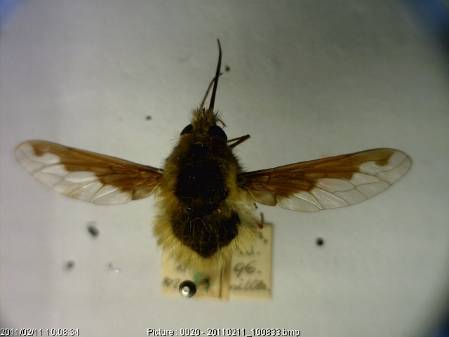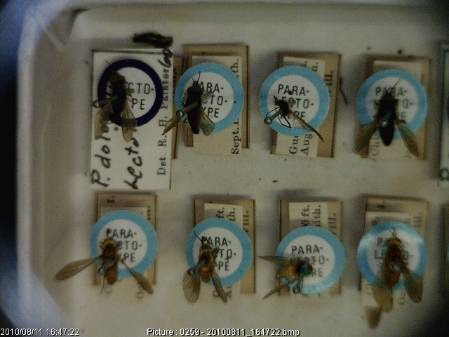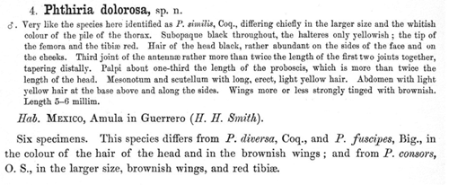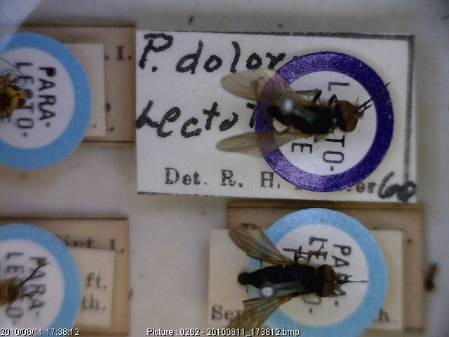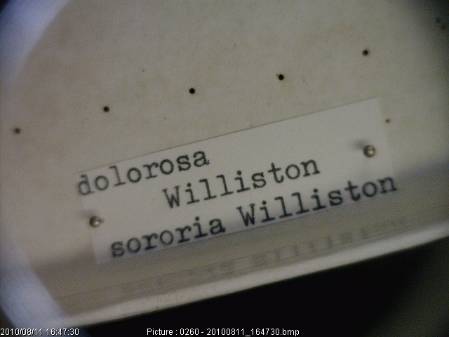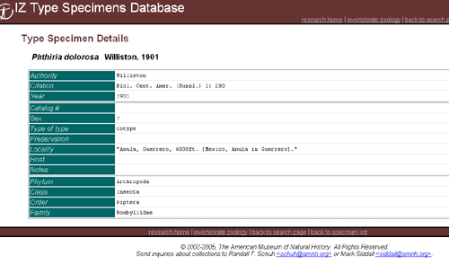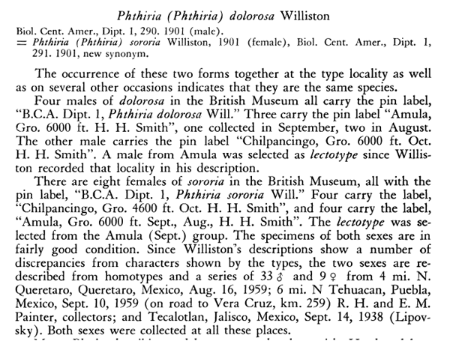Ok so here is some of the recuration work that I do;
At the moment I am working on the Bombyliids - the bee flies, and I am recurating the subfamily Phthiriinae as I type . These are fairly small, stripy flies unlike our more familiar Bombylius major we see flying around our gardens.
This collection was transferred some time ago from the very old slats into these unit trays which are no longer deemed acceptable housing - pests can get into the substrate etc, and many of the labels are completely out of date. As well as the poor housing the Museum was donated a large collection which I am incorporating into the main collection.. Sometimes the recuration is easy, all the specimens are correctly labelled and there have been no taxonomic revisions. Other times it’s not so easy….
Take this one for example. Here is a snapshot of some of the specimens in the unit tray
And here is the description in the most up to date catalogue (2003);
‘dolorosus
Phthiria dolorosa Williston, 1901: 290. TYPE LOCALITY: Mexico (Guerrero) [L designated by Painter & Painter (1962: 35) in BMNH*].
Phthiria sororia Williston, 1901: 291. TYPE LOCALITY: Mexico (Guerrero) [3S in AMNH*].
DISTRIBUTION: Nearctic: Mexico (Guerrero, Hidalgo, Jalisco, Morelos, Puebla, Querétaro de Arteaga).’
What this description is telling us is that species dolorosa was originally described by Williston in 1901 in the genus Phthiria, and you can find this in that publication on page 290. The material that he used to base this new species on was from Mexico (Guerrero to be more precise).
This species is now no longer in the genus Phthiria, and in fact was moved to the genus Neacreotrichus by a husband and wife team Painter and Painter in 1962, but I will get back to this later. In the description we are also told that there is now a L in the BMNH (this means Lectotype in the British Museum of Natural History, us!). Moving species around genera is a very common occurrence- taxonomists disagree all the time and sometimes species may move many times! It is hard to keep track of sometimes!!
Here is the original description that Williston wrote about this species;
He states that there were 6 specimens and the exact locality is given and that they were collected by H. H. Smith. We have four in the NHM and these are indeed the specimens mentioned in this description. The other two specimens are in another museum or lost with time (at least one is at the American Museum of Natural History AMNH).
I will come to the lectotype part in a moment. However, when there was no holotype designated (the specimen from which the species is described) then all or some of the specimens from the series that were collected are designated Syntype status, which is what originally happened here.
Now getting back to the present labels and the designation of lectotype; this is because an individual specimen needs to be the reference for the name, as when a name is based on a series of several specimens there may be problems if the series is later found to contain more than one species (as sometimes happens), and so one of the Syntypes is chosen as a Lectotype. So we can see that yes indeed we have P.dolorosa designated as LT and four PLT. From the most current catalogue we see that this was done by Painter and Painter in 1962. (i hope that you are all still following this!)
The label in the drawer though is now wrong and this is because when Painter and Painter decided that no this species does not belong in Phthiria (feminine) but instead Neacreotrichus (masculine) then the ending was no longer correct and so the feminine dolorosa became masculine dolorosus! This is because Latin names for both the genus and species have to be of the same gender. New labels to be made then .
…. and there is a further mystery concerning this tray of flies.
When searching the original description Williston in 1901 designated all of these flies (from the then 2 species) as syntypes. This means that no individual fly was used as the Holotype. What has happened when Painter came along was that some of the other catalogues did not record this change in status so when you check the status of the specimen for example on the AMNH site it still has them listed as Cotypes (which is an old term for Syntypes);
this needs to be changed!
And to further complicate the matter - In the latest catalogue it also states that Phthiria sororia Williston 1901 (on page 291 for the original description) is a junior synonym of dolorosus. Again this was the lovely Painter couple in 1962;
At the very beginning they describe P. sororia as a new synonym (i.e. they are infact the same species but as dolorosa was described first (albeit a few pages!!) it retains the name. In the collection there is the designation of Lectotype and Paralectypes; the lectotype designation for sororia is also in the extract from Painter & Painter’s paper! It’s in the paragraph below where they designate the lectotype for dolorosa, in this sentence: “The lectotype was selected from the Amula (Sept.) group”).
Type: | TL: Mexico, Guerrero, Amula (T BMNH) |
Now on many sites and catalogues this species has been left as a cotype whilst others as LT’s and PLT’s!! So by updating our own catalogue and with the data being fully accessible on the web hopefully more people will respond to the change in status (it was only 49 years ago that it happened…. ) – if there were any changes though we would all the original labels on the specimens – in fact I would never remove a label but instead add one if I discovered new information on the nomenclature etc…you can often have large stacks of labels which can be problematic on a short pin!!
I will edit the database to update the nomenclature changes and if the types do not already have one, I will add a specimen number. These are so we can track all of the type material. The collection at the NHM is the most type rich in the world and we have rather a larger number of specimens to database!! We are progressing though and you can check on line how we are doing!!!
As well as the electronic editing we re-house the specimens in conservation grade unit trays. These are lined with plastozote – which is inert and so does not release any chemicals etc which could result in damage to the specimens. Everything from the glue that is used, the paper that the labels are made from to the wood that is used to construct the drawers has been researched to determine whether it is suitable for museum collections. We will spend a long time researching a new product before we use it. After all the collections date back to the 1680’s – we want to ensure that they are around for a few more years!!!
All done I move onto the next species. Only another 4000 to go .



